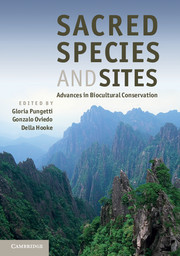Book contents
- Frontmatter
- Contents
- List of Contributors
- Foreword
- Preface
- Acknowledgements
- Introduction
- Part I Concepts and Knowledge
- Part II Sacred Landscapes
- Part III Sacred Sites and People
- Part IV Sacred Species
- Part V Sacred Animals
- Part VI Sacred Groves and Plants
- Part VII Implementation and Conclusions
- 25 Sacred species and biocultural diversity: applying the principles
- 26 Sacred sites, sacred landscapes and biocultural diversity: applying the principles
- 27 Conclusions: the journey to biocultural conservation
- 28 Epilogue: a Spiritual Circle
- Index
- Plate Section
- References
27 - Conclusions: the journey to biocultural conservation
from Part VII - Implementation and Conclusions
Published online by Cambridge University Press: 05 August 2012
- Frontmatter
- Contents
- List of Contributors
- Foreword
- Preface
- Acknowledgements
- Introduction
- Part I Concepts and Knowledge
- Part II Sacred Landscapes
- Part III Sacred Sites and People
- Part IV Sacred Species
- Part V Sacred Animals
- Part VI Sacred Groves and Plants
- Part VII Implementation and Conclusions
- 25 Sacred species and biocultural diversity: applying the principles
- 26 Sacred sites, sacred landscapes and biocultural diversity: applying the principles
- 27 Conclusions: the journey to biocultural conservation
- 28 Epilogue: a Spiritual Circle
- Index
- Plate Section
- References
Summary
Introduction: natural and spiritual life
Early societies were small and close to nature. They were also intensely vulnerable and over the generations traditional ways of life evolved and enabled them to live in harmony within their customary habitat. Man also turned to religion to explain the features he could not understand and against which he sought protection, especially nature in its most dangerous and threatening forms such as storms, floods and earthquakes. Yet many societies also felt the need to thank nature for its bounties. Intervention with nature frequently involved a superior power and established rites which allowed communication with deities and the universe; shamanistic rituals suggested since millennia in prehistoric art may have been one of the earliest manifestations of such beliefs.
A sense of spirituality appears to have evolved within the human brain and soul, which renders it, as far as we are aware, different from that of all other creatures, and most early societies saw themselves as mere components of a richly endowed universe. There are also remarkable similarities across cultures: almost every society has its own creation story, for instance. As the raising of domestic animals and the cultivation of crops spread around the world, man had still to subjugate his needs to the requirements of nature and the resources available. Pests and diseases could be fatal to man and animal in growing societies; also, the over-exploitation of the land could result in soil erosion leading to the irrevocable destruction of local resources.
- Type
- Chapter
- Information
- Sacred Species and SitesAdvances in Biocultural Conservation, pp. 442 - 453Publisher: Cambridge University PressPrint publication year: 2012



